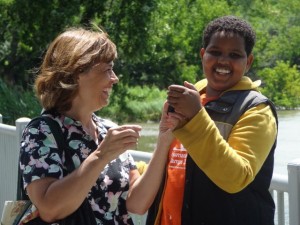The recurring question in American education for the past 20 years has focused on how to improve learning outcomes for students. The drumbeat of reform has been especially loud since NCLB (2001), the adoption of Common Core State Standards (2009), and the Race to the Top initiatives (2009). In contrast to the competitive nature of these “reforms” that are determined through high stakes testing and punitive measures, ongoing educational research continues to document the impact of collaborative cultures that promote teaching and learning for student success in schools.
Educators in the field, and aspiring pre-service teachers should take heart from the evidence that shows that community and collaboration are key factors in student achievement. Competition affords a false equivalency in education, and increases potential for failure for schools and students.
In this blog, we are committed to demonstrate how building collaborative cultures can be accomplished at the individual, local, district, state, and national level. There are many challenges to impede progress, but we must continue to find the silver linings, and act on them!
I’d like to share two items (of the many) I read recently, about the benefit of collaborative cultures that are in the best interests of our wonderful students and talented educators. Teachers know that working together is smarter and that students also need opportunities to learn collaboration skills for real life success.
Linda Darling-Hammond, Charles E. Ducommen Professor of Education at Stanford University and the Faculty Director of the Stanford Center for Opportunity Policy in Education recently described the results of the 2013 TALIS survey (Teaching and Learning International Survey) which was conducted by the OECD (Organization for Economic Cooperation and Development) in schools throughout the world. The focus of that survey was on teaching and learning, not on test scores of students.
In a June 30, 2014 Huffington Post article, “To Close the Achievement Gap, We need to Close the Teaching Gap,” she provided some insightful conclusions about the state of American education, from the perspective of teachers and how they are supported in their professional roles. This should be required reading for educational policy makers and administrative leaders. Among the results is the fact that in the United States, teachers work longer hours, and have less opportunity for feedback and collaboration with peers. High performing countries on the PISA test use teacher collaboration as an indicator that leads to student success. The equitable distribution of resources for education in other developed nations is another indicator for student success. Disadvantaged students in the U.S. have fewer resources than comparable developed nations, particularly in large urban systems and other areas of poverty. Read the post for her suggestions, and think about how we can use the results from this survey to raise awareness of inequitable educational policies in our own state and districts. Here’s an opportunity for school librarians to stand with colleagues and community members to refocus the discussion about teaching and learning, and how to measure performance.
Justin Minkel, a second/third grade teacher in Arkansas pens a blog, Teaching for Triumph, and he was invited to lunch with three other teachers from high poverty districts to tell President Obama and Secretary of Education Arne Duncan about the challenges that they face in the classroom. He has posted a report of that meeting, “What We Shared with Obama.” In it he recalls the salient points that the teachers made about teaching and learning. One of the key factors for success is the collaborative culture within their schools. The three other points he also makes get to the heart of the commitment that teachers have for all their students, not just those who are destined for success. Take time to read his blog and you will be inspired. Let’s hope that the President and the Secretary were listening, and will think about supporting collaboration, not competition…
References:
Darling-Hammond, Linda. “To Close the Achievement Gap, We Need to Close the Teaching Gap.” Huffington Post (June 30, 2014). Weblog. http://www.huffingtonpost.com/linda-darlinghammond/to-close-the-achievement_b_5542614.html
Minkel, Justin. “What We Shared with Obama.” Teaching for Triumph: Reflections of a 21st Century ELL Teacher(July 10, 2104). Weblog. http://blogs.edweek.org/teachers/teaching_for_triumph/2014/07/what_we_shared_with_obama.html
Image:
Judith Kaplan Collection: Carole Renca and friend-used with permission


Just read about a CT school’s success with changing a schedule to include teacher collaboration time. That’s what we are talking about:
http://hechingerreport.org/content/lessons-school-scrapped-longer-student-day-made-time-teachers_16663/
Just read about a CT school’s success with changing a schedule to include teacher collaboration time. That’s what we are talking about:
http://hechingerreport.org/content/lessons-school-scrapped-longer-student-day-made-time-teachers_16663/